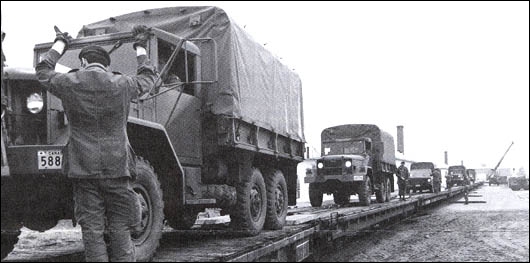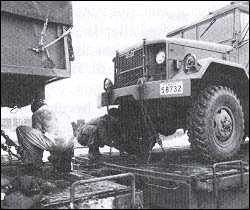|
|
|
Volume 16 Number 1
|
1986 - The Year of Living Safely
|
Jan. 15, 1986
|
Railway Carries Military's Materiel
By Timothy R. Humphreys

Good Form: Military
personnel efficiently load their equipment onto flat cars at Petawawa, Ontario, for the move to alberta for a 75 day
military exercise. CP Rail employees in three regions were involved in the military's movement of roughly 1,300 flat
cars, box cars, and highway trailers to and from Alberta.
Toronto - As the year comes to a close, employees in three regions who
took part in the movement of military equipment for Rendez-vous '85 this summer can look back with a
feeling of accomplishment.
Using roughly 1,300 tie-down flats, box cars, and railway-owned highway trailers, CP Rail
handled the bulk of the transportation requirements for this year's military exercises in Alberta.
| |

Preparing for the
Move: Military personnel, trained by CP Rail employees tie-down equipment onto a flat
car at Petawawa, Ontario, prior to transport to Rosyth, Alberta, for Rendez-vous
'85.
|
It was the third time that CP Rail has handled this type of move and the experience gained in 1981 and 1983
contributed greatly to this year's success.
"It was the biggest move that we've ever done for the Canadian Armed Forces", commented Maurice Daynard,
director, sales for CP Rail in Smiths Falls, Ontario. "We had a few minor problems that we've learned from, but
all in all the move couldn't have been more successful".
The railway's role was to get specialized medical equipment in the form of self-contained field
hospitals, guns, tanks, jeeps, armored cars, and personnel carriers to the Canadian Armed Forces Bases at Wainwright
and Suffield, Alberta, on specific dates during spring and summer so that they could be used during the 75 day
military exercise.
"Transit time was very crucial", said Mr. Daynard. "A one day delay could have thrown everything out
of schedule for the military".
Mr. Daynard was involved in CP Rail's participation in Rendez-vous '83 and again acted as liaison with
the Department of National Defense in Ottawa this year. This summer's move by CP Rail dwarfed that of 1983 in terms of
size and logistics, he said.
MIXED FREIGHTS
In 1983, CP Rail essentially moved everything from Canadian Forces Base Petawawa to Rosyth, Alberta, where it was
taken overland the 35 kilometres to Wainwright; there was only one point of origin for traffic handled by CP Rail
employees.
"This year we were handling equipment that was being switched to us from Valcartier, Quebec. Other shipments
originated from Petawawa, Kingston, Esquimalt, Shilo, Brandon, and Enniskillen", explained Mr. Daynard.
"Some of the shipments were handled as solid trains. Others were incorporated into mixed freight trains depending
on when it was required in Wainwright".
Rates, schedules, equipment availability, weight differentials, and the training of armed forces personnel on how to
load and unload rail cars and securely tie-down equipment with chains were but a few of the details
ironed out between the military and CP Rail officials during the nearly two years of planning that preceded this
year's move.
Wayne Lucas, of the transportation department in Montreal arranged for all the rail equipment, with Doug Courtney
securing the necessary motive power and co-ordinating the movement of the various trains.
"The operating people at each of the loading and unloading locations deserve special mention for the attention
they gave to the switching requirements necessary to make things work well", said Mr. Daynard.
"Also, the mammoth co-ordination efforts of these people at Rosyth and Suffield during the loading
and unloading ensured a successful rail movement and military exercise".
COMPETITIVE
Meanwhile, Paul Godman, of CP Rail's marketing and sales department in Toronto, had worked out a competitive rate
package for the move while Rollie Michaud, of the railway finance department in Montreal, and Yves Berube, of
accounts receivable, efficiently handled the billing of the various moves as they took place.
"There were many other employees involved; the employees who helped train military people on how to
tie-down their equipment on the rail cars, the men who supervised the various operations, and the
dispatchers who made sure the trains got through without delays", said Mr. Daynard.
"It was more than a 100 percent effort and the successful results from the move bode well for all the CP Rail
employees involved".
This CP Rail News article is
copyright 1986 by the Canadian Pacific Railway and is reprinted here with
their permission. All photographs, logos, and trademarks are the property of the Canadian Pacific Railway
Company.
|
|